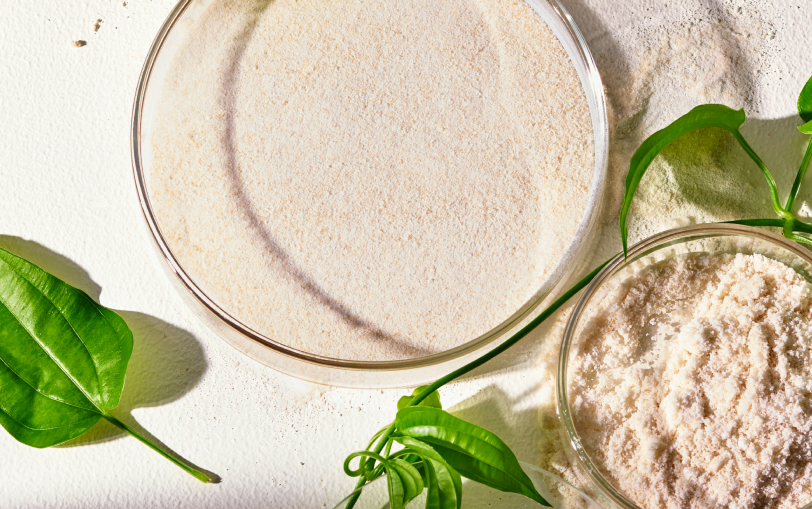science
The Top 10 Benefits of Maca Root: Nature’s Superfood
On This Page

The Maca root benefits are incredible. Check out this superfood and the many reasons why you should be including it into your diet.
Maca root benefits date back to the Andes Mountains of Peru, where the maca roots were administered over 2,000 years ago to treat and sometimes cure various health ailments. Maca has been used to treat nutritional deficiencies, support healthy energy levels, enhance fertility in both males and females, improve memory, protect against ultraviolet radiation, and promote balanced hormones.
This multifaceted superfood is sister to a food you're likely more familiar with: broccoli. They are both in the same family, referred to as crucifers. Maca tastes nutty, resembles a turnip, and is light brown, orange, or red, depending on the type of maca.
Beige maca root is the type that is most commonly consumed and most readily available. Read on to learn about some of the wellness-enhancing advantages of maca and if maca can benefit you.
What Is Maca Root?
Maca is a cruciferous vegetable and a member of the Brassicaceae family. This makes it sisters with other flowering veggies like broccoli, cauliflower, and cabbage. Common nicknames for maca include Peruvian ginseng, ayak willku, and ayak chichira.
Maca is an edible and medicinal tuber plant found in the Andes region of Peru and is one of the most popular supplements in America and worldwide.
What is an Adaptogen?
Evidence-based complementary and alternative medicine suggests that maca root is also an adaptogen. In herbal medicine, an adaptogen is a natural and consumable substance that assists the body in adapting to stress and rebalances imbalanced bodily processes.
Ginseng is one of the most well-known adaptogens in Traditional Chinese Medicine, hence maca’s nickname: Peruvian ginseng.
When consumed, an adaptogen has no agenda and is able to adjust to certain abnormalities it encounters. This means that for some people maca root can help stress levels, while for others it can work to rebalance their PMS-induced fatigue.
Maca is a universal supplement with beneficial health impacts.
Maca Root vs. Maca Powder
Maca root is the part of the maca plant that harvests beneath the soil. It looks almost identical to the white of a turnip. The leaves of the maca plant are discarded since they're inedible.
In Peru, maca root is generally consumed as a regular vegetable and added to stews or soup. However, to make maca root accessible and non-perishable, it is made by drying and grounding the roots into maca powder.
There are two types of maca powder. Regular maca powder is prepared following the methods above.
The other type, sometimes referred to as maca extract, follows another method. To remove the extra starch in the maca root, the dried vegetable is boiled and then pressurized, extracting the starch as well as other indigestible fibers. It's an extra step in the powder-making process that creates a final product designed with maximum nutrient absorption in mind, whether consumed in capsule or powdered form.
Maca Root Benefits for Health
This born-in-nature superfood has myriad health benefits for everyone. Although it is most often administered to balance hormones, maca can be used for everything from boosting energy levels to reducing stress.
It's best to consume an organic maca root powder, since non-organic varieties are filled with toxic pesticides that negate the health benefits of taking maca in the first place.
Maca root contains over fifty vitamins and minerals, including vitamins B1, B2, B12, vitamin C, zinc, and iron. It can assist in supplementing any nutritional gaps in your diet. Maca can also facilitate enhanced calcium absorption to keep your bones healthy.
As an adaptogenic herb, maca root benefits diversify to meet your needs. Read on below for some of the more common benefits of maca root in men and women.
May Boost Libido
Maca is famously known as an herb with aphrodisiac properties.
The long-chain fatty acids of maca trigger a pleasure response in the body. Maca increases sexual desires and sensations and is a trigger for pleasure.
For men and women, maca is shown to enhance libido and lead to improved sexual function. The data on this is limited, as libido is a subjective topic that is difficult to quantitatively measure.
Since maca also boosts energy and may support a healthy mood, these factors correlate with enhanced libido. Overall, though, studies show that when maca is consumed regularly it acts as an aphrodisiac and helps maintain healthy levels of libido.
May Improve Male Fertility
Research suggests that maca may influence sperm count. This is due to the maca root's ability to support higher and healthier sperm counts.
Incorporating maca root into an everyday routine may boost fertility success in the long run. Whether you and your partner are looking to conceive now or in the future, maca can assist in keeping sperm healthy in preparation for conception.
May Help Reduce Symptoms of Menopause
One of the key benefits of maca is its adaptogenic effects. Menopause symptoms often stem from hormonal fluctuations and imbalances. Maca root can help rebalance any offset hormonal levels to reduce symptoms associated with menopause. Menopausal symptoms like hot flashes, night sweats, sleep challenges, and mood swings can be frustrating. Taking an organic maca root supplement regularly can help soften or even alleviate these frustrations and have you feeling energized and rebalanced.
Boosts Energy and Endurance
Maca naturally supports energy levels and athletic performance. It is a more reliable source of energy than coffee since it is not habit forming. It can support your stamina and endurance, so it is especially beneficial for athletes and those leading active lifestyles.
Maca is often consumed by long-distance athletes, bodybuilders, and professional athletes. It's a "trade secret" of professionals. Maca may also boost the ability to develop muscle, which improves performance results post-training.
Soldiers used to consume maca to boost their energy on the battlefields. Today, maca makes an excellent alternative to modern caffeine dependency and icky energy drinks.
In a study of 175 participants who consumed maca for 12 weeks, those consuming the maca root reported more energy than those who weren't.
Helps Improve Mood
Since hormones are directly linked to mood, maca may help improve mood. Maca is shown to promote a balanced mood, ease stress, and boost energy.
The flavonoids in maca may be the active constituents responsible for supporting a happy mood. About 80% of participants in this study reported improved moods over the 12 week period that maca was administered at 3 grams/day. Maca also helps the body deal with stress. Maca root stimulates the body's natural self-defense system. It balances the adrenals which are responsible for how the body reacts to environmental stressors.
Maca has properties that can promote calmness and a happy mood. This effect may be associated with lowering cortisol levels – sometimes known as “the stress hormone” –while helping raise levels of dopamine, or “the happy hormone.” This study found that after 6 weeks of supplementing with maca levels of dopamine increased and antioxidant status improved in the brain tissue.
May Help with Bone Health
There’s reason to believe that maca may also benefit bone health. Animal studies, in particular, have shown some strong evidence for maca’s support for bone health. This study, for example, found that maca has “protective effects” on the “bone architecture” of rats. Moreover, maca contains N-benzyl-palmitamide, a long-chain fatty acid amide that promotes osteoblasts. Osteoblasts are cells that boost bone health.
While maca may support bone health based on preliminary animal studies, there’s stronger evidence for using vitamin D, calcium, and vitamin K for supporting bone health.
May Reduce Sun Damage
Much more research is needed to establish a firm connection between maca and protection from sun damage. That said, this study shows potential in animal models in terms of reducing UV-related skin damage. This likely has to do with maca’s benefits for managing oxidative stress. If you’re looking for a tested way to reduce sun damage, you should use topical sunblock or UV-protective clothing.
May Help with Memory and Learning
Maca may also help support memory and learning. One animal study found that the aqueous extract of black maca had neuroprotective properties in mice. Another study of mice found positive results for cognitive health. While these studies are promising, more research is needed to demonstrate that maca has cognitive benefits in humans.
Has Antioxidant Properties
Antioxidants help the body fight off harmful free radicals, thereby promoting a range of health benefits. That’s good news for lovers of maca! Studies have found that maca possesses antioxidant-like properties. Maca also promotes the production of natural antioxidants in the body.
May Balance Estrogen Levels
While more research is needed, preliminary findings in an animal study suggests that the plant sterols in maca can balance hormone levels, including estrogen levels.
Maca Root Dosage
Maca can strongly and positively impact people within a few weeks of incorporating maca.
Maca is a powerful adaptogen, so it is best to start with small doses. Based on studies the suggested effective dosage for maca powder can range between 1.5 grams and 3 grams, but supplements can be found in higher doses up to five grams.
Since maca is an energy-boosting adaptogen, it’s best taken early in the morning, As taking maca too close to bedtime may cause difficulty falling asleep.
Can you take too much?
A good rule of thumb when it comes to taking maca is not to take more than what’s recommended on the packaging. You can also check with a medical professional about the right dosage for you. Generally speaking, though, it’s unlikely that taking maca will cause any problems for you. It’s impossible to overdose on maca. So, use your best judgment, and watch out for any potential side effects (described in more detail below).
Maca Root Side Effects
Maca is a vegetable and is considered safe for most people to consume. However, there are always precautions.
Since maca does impact hormonal balance, it is usually best to avoid it if you are pregnant or breastfeeding. Maca also contains goitrogens, substances that can disrupt thyroid hormones.
For those with thyroid issues, it may be best to avoid maca.
For most people, maca positively impacts any hormonal imbalances, but in small instances, it may have a reverse effect. Due to its potency and stimulative effects, it can cause the body to produce more estrogens.
How to Take Maca Root?
Since it's a powder, you can consume maca in many different ways. Maca adds excellent flavor to smoothies – plus it is good for you!
Maca has an earthy, warm, and nutty flavor, making it great for making smoothies more creamy. You can pair maca with strawberries, almond butter, dates, and some almond milk for a balancing nutritious smoothie.
Maca root powder is also available in encapsulated form. You can simply take the capsule with your breakfast for enhanced energy and mood throughout the day.
Just a small serving of maca root benefits your entire body each day. Check out our supplement quiz to learn what your body needs!
The Bottom Line
Maca root is a vegetable that is increasingly prepared as a food or taken in supplement form. Maca powder, in particular, has been gaining popularity among health enthusiasts – and for good reason! Studies show that maca may boast a range of health benefits, including improved libido, improved mood, enhanced energy, improved menopause symptoms, and more. More research is needed to conclusively demonstrate maca’s effectiveness. Talk to a medical professional about whether maca may be helpful to you.



